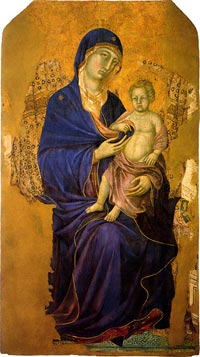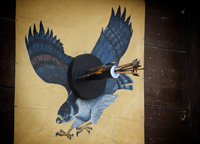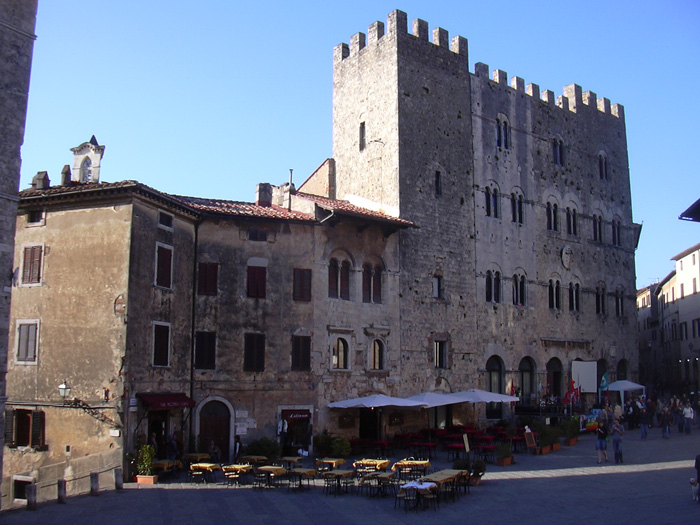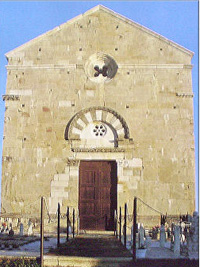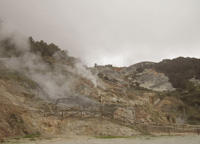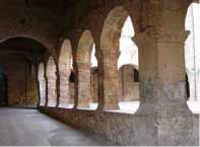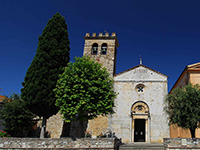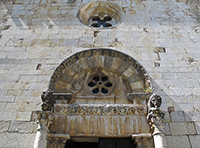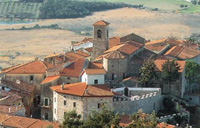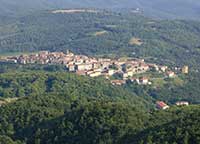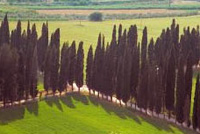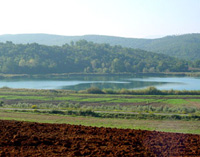Massa Marittima |
| Massa Marittima, a small but delightful centre of art is situated in the Maremma region, and set amongst the Colline Metallifere. The town is surrounded by the typical Maremma countryside. In its historic centre, the ancient alleyways intertwine, climbing steeply to the evocative upper quarter, from where you can enjoy a stupendous view out over the valley as far as the sea. Main sights include the wonderful Cathedral of San Cerbone, the Palazzo Comunale, the Palazzo del Podestà, home to the Archaeological Museum, and the Fonti dell’Abbondanza (Fountains of Abundance) with their famous fresco. In May, Massa Marittima returns to the Middle Ages for the biannual Balestro del Girifalco (Falcon Crossbow Contest). On the second Sunday in August the town of Gavorrano holds a costumed medieval festival, the Salto della Contessa, a historic recreation of the fascinating legend of Pia dei Tolomei, wife of Nello Pannocchieschi, who was said to have been killed in the Pietra castle in the countryside of Gavorrano under the orders of her husband. |
||
| Massa Marittima, situated between Follonica and Siena, rises on a hill that dominates the plain of the rivers Pecora, Zanca and Noni. The panorama embraces all the gulf of Follonica, comprising the islands of Elba and Montecristo. Massa Marittima is a interesting medieval town rich of many artistic evidences. Of probable Etruscan origin, the city conserves many monuments of its more prosperous period. The city is subdivided in three parts, the low part (or old city) where predominate the Romanesque style and the high part (or new) but founded in 13th and 14th centuries and the Borgo. Piazza Garibaldi, considered one of the most mature examples of medieval urban Tuscany, where almost all of the major civil and ecclesiastical monuments stand out: the Duomo, one of the most refined sacred buildings of Tuscany, the Palazzo Pretorio and Palazzo Communale. The visit can begin from Piazzale Mazzini, where is a comfortable payment parking, here is the Palace of Abundance (1265) characterized from three ogival arches. Soon we enter one of the most beautiful public squares of Tuscany, the Garibaldi square, with many medieval buildings and the most important and beautiful monument of Massa Marittima, the Cathedral. The Duomo, dedicated to San Cerbone, is one of the most beautiful examples of the Romanesque-gothic architecture. The construction turns out raised on a podium with stairs and is arranged diagonally regarding the rest of the square. The facade in two orders surmount from a gable. Beautiful it's also the relief of the architrave of the doorway with episodes of the life of San Cerbone. The inside in three apse is supported from columns in travertine with fine carved corinthian capitals. The inner contro-facade brings traces of frescoes of centuries 13th-14th, while the rose-window is decorated by a stained glass window with the image of San Cerbone in front of Pope Vigilio (14th century). In the Cathedral are interesting works of art, between which are (at the beginnig of right aisle) the baptistry in travertine of 1267 with reliefs of the life of San Cerbone and the New Testament, work of Giroldo da Como next it's a stoup in marble of 13th century; in the transept it's the Chapel of the Crocifisso with a crucifix probable work of Segna di Bonaventura (13th century); under the apse it's the Arca of San Cerbone, a urn in marble with high reliefs executed from Goro di Gregorio in 1324; in the left transept is the Chapel of the Madonna with a altar-piece representing the Madonna delle Grazie (1316) attributed to Duccio da Buoninsegna. [read more] The Museum of Sacred Art opened in 2005 and is based in the church of San Pietro all’Orto, the most ancient church in Massa Marittima. The ancient Church of San Pietro all’Orto is located in the upper area of Massa Marittima’s historical centre. Facing onto Corso Diaz, it is part of a larger medieval architectural complex in which can also be found a convent, with a cloister, of the same name and the Church of St. Augustine. The Museum currently displays pieces from the cathedral and other churches in town, witnessing the attention paid to religion in the past, including vestments and church plates and funeral findings. Inside are frescoes of the Sienese school dating back to the 14th and 15th centuries and an interesting 13th century painting depicting La Madonna col Bambino (The Madonna with Child). In the adjoining convent, you can now find the largest museum in Massa Marittima, consisting of the Martini Collection, the Museum of Mechanics and the Museum of Holy Art. Housed in this last museum, among numerous medieval masterpieces, is the splendid tablet of the Maestà by Ambrogio Lorenzetti, painted specifically for the Church of San Pietro all’Orto. [read more]
|
Cattedrale di San Cerbone, Massa Marittima, Grosseto
Madonna delle Grazie, attributed to Duccio di Buoninsegna |
|
| In front to the left side of the Cathedral is the Palazzo del Vescovado, rebuilt in 1914, on an angle of the palace is a column with a wolf (1474), symbol of Siena, that it was used for posting of the proclamations. In front of the facade of the Cathedral it's the beautiful Palazzo Pretorio built in 1230 like residence of the podestà, of which conserve, on the facade, numerous coats of arms, today it's used as Archaeological museum, coming down to the right of Palazzo Pretorio we reached the medieval building of the Mint, where in 14th century the Municipality of Massa Marittima minted their own coins, not far is the San Bernardino Gate and the Salnitro Gate of the Town walls. Returning in the Garibaldi square continuing to right of Palazzo Pretorio are in order: the House of Conti di Biserno (13th century), the Municipal Palace (14th century) in travertine with inside beautiful frescoes of 16th century. In front of the Municipal Palace it's the Loggia del Mercato, a reconstruction of 19th century. Other interesting building in the low part of the city are the former church of San Michele, today center of the Municipal Library, and in the vicinities the San Rocco Gate (13th century). |
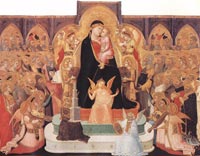 Ambrogio Lorenzetti, Maestà in the convent San Pietro all'Orto |
|
| Continuing from the Loggia del Mercato in the via Moncini, we reach after a steep climb the Porta alla Silici (14th century), past this gate is the Matteotti square, center of the New City, here are some works of fortification like the Torre del Candeliere, rest of the old fortress built in 1228 and joined in 1337 to the Senese Fortress from an impressive arc. The big Fortress Senese, the Cassero Senese, built from 1335 have been partially demolished (1744 and then 1845) but it's still remain an important construction. In the square it's also the Palazzo delle Armi (1443), in the vicinities is the San Francesco Gate, with a beautiful part of the town walls, and then beyond is the Romanesque-gothic church of San Francesco (13th century) and the San Rocco Gate. The Romanesque-gothic church Sant'Agostino (beginning of 14th), with the annexed convent San Pietro all'Orto that has a beautiful cloister (12th-13th century), is recently restored. It houses the Museum of Sacred Art, where is exposed the Maestà of Ambrogio Lorenzetti. More ahead is the convent of the Clarisse (13th century). Museo d'Arte Sacra di S.Pietro all'Orto
The Tree of Fertility | The Albero della Fecondità |
||
| The Albero della Fecondità is a peculiar fresco found on one of the walls of the Fonti dell’Abbondanza in Massa Marittima’s Piazza del Duomo. The building itself is located on Via Ximenes to the left of the Duomo,
as you walk out of the piazza towards the city walls. It was the
original site of the city’s water supply and was built in 1265. Located inside one of Massa Marittima’s main public fountains, the Fonte dell’Abbondanza, the Tree of Fertility consists of a sizeable tree that spans the rear left wall and is fanked (and framed) by the structural supports of the vault. Unquestionably, the tree’s most extraordinary attributes are the twenty-five large phalli with accompanying testicles suspended from branches in a reasonably symmetrical arrangement. Below the branches stand eight female figures together with a ninth, indiscernible body; two figures are consumed in a heated dispute over a phallus, tugging at one another’s hair. Some stand complacent in soft discussion, while another frantically combs the tree for a phallus, all under the auspices of hovering eagles curiously reminiscent of an emblem employed by a political faction.[1]
|
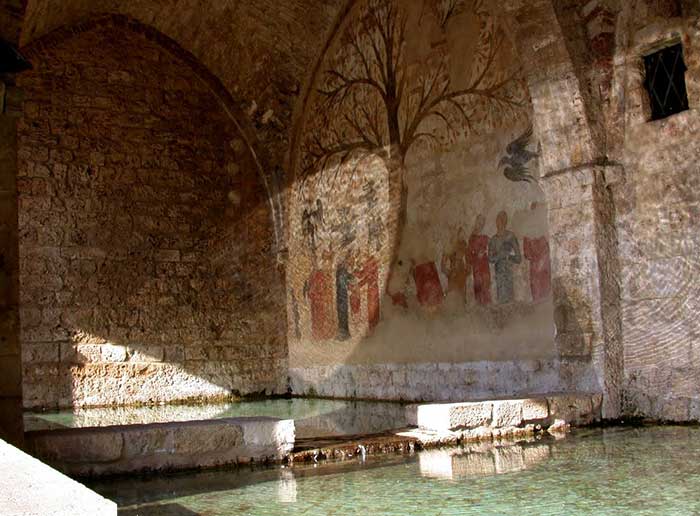 Fonti dell’Abbondanza |
|
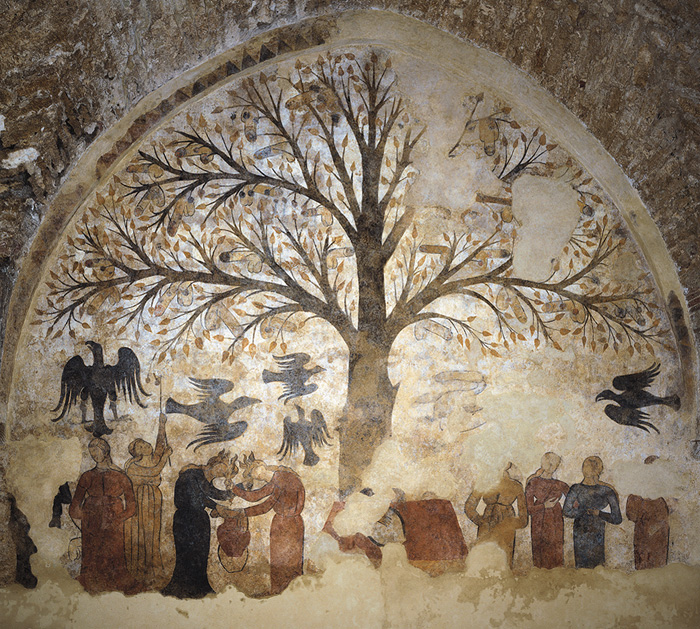 |
||
The “Tree of Fertility” on a large wall of the building housing the public fountain called the Fonti dell’Abbondanza at Massa Marittima, fresco,1276-1300
|
||
A closer, more formal inspection of the Mural reveals a myriad of information. A finely executed tree, with a structural resemblance to a fig tree, occupies most of the Mural’s visual field. The tree’s branches support twenty-five budding phalli with testicles, quite literally signifying the fruit of the tree, juxtaposed with dark, spherical,fruit-like forms. The phalli act as a visual device corresponding to the silhouette of the wall inset (and geometrical painted brick frame), tracing a curvilinear path for the eye to follow. The tree accentuates pictorial harmony and balance by means of its trunk and lower branches; both demarcate a clear horizontal and vertical axis. The latter, delineated by the tree trunk, may offer considerable insight into the distinctive shift between the behaviour of the figures in the left and in the right sections. Eight (and possibly nine) discernable female figures, dressed in medieval garb, stand below the tree. On the far left, a female figure in navy blue appears to be clutching a small black rope lassoed to a foating phallus; another figure, cladin yellow ochre, prods at a branch with a stick or may even be pulling the branchwithin her reach with a rope. To the right of this figure, two female figures, locked in ferocious combat, wrench each other’s hair.[1] |
||
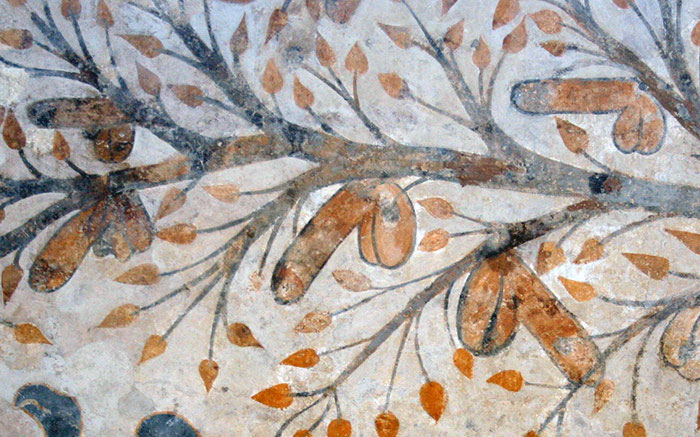 |
||
|
||
The unusual 13th century Tree of Fertility fresco was discovered by chance and has recently been subjected to a three-year restoration. According to Gabriele Galeotti the restorers have compromised the authenticity of the fresco. 'The work was intended as a symbol of fertility with the penises being crucial to the intention of the art but now these have been removed and the message is therefore no longer there. Galleria delle Fonti dell’Abbondanza, Piazzale Mazzini Massa Marittima |
||
| |
||
Musei di Massa Marittima Convento e chiesa di Sant'Agostino di Massa Marittima e Chiesa di San Pietro all'Orto (it) |
||
| Wine in Tuscany | Strada del Vino Monteregio di Massa Marittima The best-known DOC wine here and the one that is most readily available is Morellino di Scansano, a dry, fragrant, medium-bodied red. Morellino is the local name for the Sangiovese grape around the town of Scansano. The most widely available Morellino di Scansano wines in the United States include Moris Farms, Fattoria Le Pupille and Massa Vecchia. [read more] |
||
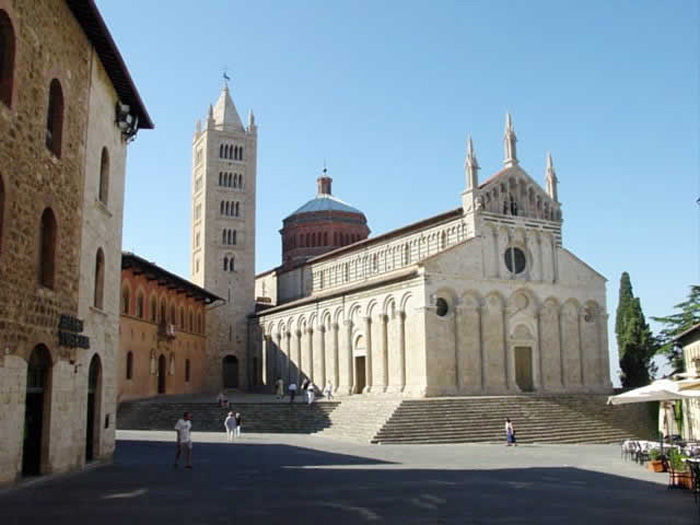 |
||
Piazza Garibaldi, Duomo |
||
Massa Marittima’s Balestro del Girifalco |
||
| Massa Marittima returns to the Middle Ages for the biannual Balestro del Girifalco (Falcon Crossbow Contest)), one of the biggest and most impressive festivals in Southern Tuscany. The a festival was first held in the early years of the 14th century. Today it is one of the biggest and most impressive festivals in Southern Tuscany. The Balestro del Grifalco (Gyrfalcon Archery) in Massa Marittima takes place twice a year: on the fourth Sunday in May and then on August 14th. The Balestro del Girifalco is a test of skill, speed and strength as 24 men battle for the glory of their terzieri. At the hands of the Società dei Terzieri Massetani, Massa Marittima is decked out in cloth banners and bright-coloured flags. Some are white, red and green for Cittanuova, some are white, black and yellow for Cittavecchia and others still are gold, blue and red for Borgo. These are the colours of the terzieri, the ancient quarters of Massa Marittima that will compete during the festival. Tradizioni popolari della provincia di Grosseto | Il Balestro del Girifalco |
||
 |
||
Lupa, Piazza del Duomo, Massa Marittima [1] |
||
|
|||
Piazza Garibaldi, Palazzo Comunale |
|||
|
|||
| Campiglia Marittima, maintains intact many aspects of the medieval town. The built-up area is dominated by the Castle, built perhaps between the 8th and 9th centuries but then rebuilt between the 12th and 13th centuries. A part of the medieval walls is still visible, and the North Gate and the Florentine (or St Anthony) Gate are original of the era, decorated with the stone coats of arms of Pisa, Florence, Campiglia and of the Gherardesca counts. In the perfectly preserved centre, the Palazzo Pretorio has preserved its ancient austerity, bearing on its facade the coats of arms of the Captains who gave up their power from the Pisan period to the Florentine period. Inside the palace can still be seen the so-called torture chamber, that is, the room in which prisoners used to be tortured. Precisely on the left side of the Praetorian Palace opens up a wider part among the most interesting in the historic centre of Campiglia, with stone edifices with small balconies and outside staircases, medieval arches and narrow alleys. Lower down there is the beautiful Concordi theatre of the nineteenth century. A short distance form the Florentine Gate is the Church of St Anthony, founded in the Middle Ages but remodelled during the following centuries. The most interesting church in Campiglia is located a short distance from the built-up area, on the road that leads to Venturina. The Pieve di S. Giovanni, the parish church of St John, clearly Romanesque in style, was founded in 1163 and retains a lovely 12th-century altar. Outside on a lateral flank of the church there is a beautiful portal with the architrave decorated with a hunting scene from the end of the 12th century. Legend has it that the birth of the parish church can be traced back to the discovery of the mortal remains of St Florentius. Hotly contested between the inhabitants of Campiglia and those of Piombino, the remains were laid out on a cart drawn by oxen. The oxen set off towards Campiglia, and stopped in the exact place where today the parish church rises. The body of the saint is conserved at present inside the Church of St Laurence, the parish church of Campiglia. The Etruscan vestiges in the territory of Campiglia Marittima can be traced back to the territory currently included in the Parco Archeominerario di San Silvestro. The fortified village of San Silvestro, between Campiglia and San Vincenzo, was founded in the 10th century. The castle of Rocca di San Silvestro (5 km outside the village San Silvestro) isa unique example of a mine village, and probably dates back to a pre - medieval period. It is possible to see the village's city plan of Roman type, with an industrial area, the church, the iron mine. The Fortress is the center of the Parco Archeominerario di San Silvestro. |
|
||
Suvereto is an evocative medieval village with its circuit of walls still intact, situated but a short distance from the Etruscan city of Populonia and about 11 km northeast of Campiglia Marittima. This small village in the Maremma experienced its golden age during the 13th century. |
|
||
Monterotondo Marittimo rises in the valley extending along the right bank of the Milia torrent. Among the most important monuments to see in Monterotondo Marittimo we point out the Santuario della Madonna del Frassine, the remains of the Medieval fortifications and a geothermic park, Parco delle Biancane (Park of the Biancane). |
|||
| The fame of Gavorrano is connected with the poet Dante Alighieri, who in his Divina Commedia told the story of the Pia de´Tolomei who was shut in Castel di Pietra and eventually killed by the husband Nello Pannocchieschi, who wanted to marry Margaret Aldobrandeschi. On the second Sunday in August the town of Gavorrano holds a costumed medieval festival called the Salto della Contessa, a historic recreation of this fascinating legend. Seen as one of the most curious events held in Tuscany, the Salto della Contessa reconstructs the legendary death of Pia dei Tolomei. The first records of the town of Gavorrano date back to the 9th century even though it is certain that, in the past, it had been an important centre for minerals, the old mines of Ravi and Gavorrano itself bearing witness to this. Gavorrano was founded in the 11th century as a possession of the Bishop of Roselle, and later of the Alberti, the Pannocchieschi and the Republic of Siena. In the 16th century it became part of the Grand Duchy of Tuscany. In 1898 here was discovered one of the largest mines of pyrite in Europe. Today, the mines are out of use and have been incorporated into the Gavorrano Naturalistic Mining Park, where you can find the delle Rocce Theatre, a large open-air space which is the venue for cultural events. Things to see here are the Church of San Giuliano which preserves a marble statue of the Madonna with the child dating from 1300 and the Santissimo Sacramento Oratory. In this corner of the Maremma area, it is possible to admire the unique scenery composed of medieval villages and castles such as the Rocca di Castel di Pietra fortress. The municipality of Gavorrano contains the frazioni Bagno di Gavorrano, Caldana, and Filare. Parco Nazionale Tecnologico e Archeologico delle Colline Metallifere Grossetane Caldana |
|||
| Located in Caldana, in the municipality of Gavorrano, the Church of San Biagio, a rare example of sacred Renaissance architecture in southern Maremma, was commissioned in the 16th century by the Agustini family from Siena, whose coat-of-arms can still be seen at the centre of the pediment. Inside the church is the high altar fresco by Giuseppe Nicola Nasini. Another important building in the Oratory of St Anthony (Oratorio di Sant'Antonio da Padova). |
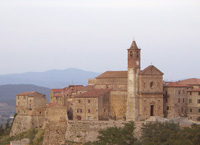 Caldana |
||
| In the medieval castle of the frazione of Prata we find not only the two towers but also the Pieve of Santa Maria Assunta. It is here that, every year in July, the historiical reenactment of 'The Killing of Tollo da Prata' takes place. Prata claims to be the place of birth of Danta's Pia. In the fifth canto of the Purgatorio in fact the Florentine poet tells the story of Pia dei Tolomei, Siena lady who died mysteriously murdered in the castle of her husband. The Pia encountered by Dante in Purgatory, was the daughter of Ranuccio Philip Malavolti, and Ms. Prata after her marriage with Tollo da Prata in 1282. She disappeared after the murder of her husband in the churchyard of Prata September 30, 1285. The walled borough of Tatti includes the medieval church of San Sebastiano. Events in Tuscany | The Killing of Tollo da Prata |
|||
| From Massa Marittima to Gavorrano 25 km |
|||
| Long route but easily to follow which ranges from the foot of the Metallifere hills to the high ground between Castiglione della Pescaia and Scarlino. At the height of Cura Nuova you pass along a beautiful shaded valley of Cypress trees for about 4 km, at the end cross the mining area of Gavorrano. Trail sign No. 7. Details (it) |
|
||
| From Gavorrano to Scarlino | |||
Long route but easily to follow which ranges from the foot of the Metallifere hills to the high ground between Castiglione della Pescaia and Scarlino. At the height of Cura Nuova you pass along a beautiful shaded valley of Cyprus trees for about 4 km, at the end cross the mining area of Gavorrano. Trail sign No. 7. |
|||
| From Massa Marittima to Lago dell'Accesa 12 km | |||
This route connects Massa to the surrounding mining area. After the initial climb up to by-pass Poggio al Santo, and crossing over the areas of Capanne Vecchie and Serrabottini. Reaching the lake dell’Accesa and La Pesta, follow towards the ruins of a Etruscan mining village. Trail sign Nos. 33 and 35. |
|||
| From Massa Marittima to Monterotondo Marittimo 13 km | |||
|
|||
| Trekking in Tuscany in the Montioni Park, Etruscan Coast |
|||
|
|||
|
|||
| Hiking in Sassetta
Point of departure/arrival: Podere La Cerreta Not far from Sassetta, a beautiful, unspoilt village in the Val di Cornia, 10 km from the sea, the forested nature park of Poggio Neri offers a variety of itineraries. The park is located in Bufalaio, about 1.5 km from Sassetta in the province of Sassetta-Suvereto. In the park there are areas for picnics which can be accessed from Casetta Fiorentina, which can be found at the exit of the village of Sassetta, on the way to Prata-Suvereto. The Tourist Information Office in Piazza Nuova offersz a route map. For more information: |
|||
| Wandering Through Villages And Hamlets by Maria Torrigiani |
|||
Wine in Tuscany | Strada del Vino Monteregio di Massa Marittima |
|||
To Massa Marittima also belong Prata, Tatti, Cura Nuova, Niccioleta and Valpiana.
|
|||
|
|||
| The Maremma | Arcidosso | Campagnatico | Capalbio | Castel del Piano | Castell'Azzara | Castiglione della Pescaia | Cinigiano | Civitella | Follonica | Gavorrano - Castel di Pietra - Pia dei Tolomei | Giardino dei Tarocchi - Niki de Saint Phalle | Grosseto | Isola del Giglio | Istia d'Ombrone | Magliano in Toscana | Monticiano | Marina di Albarese | Marina di Grosseto | Marsiliana | Massa Marittima | Montecristo | Montelaterone | Montichiello | Montenero - Montegiovi | Orvieto | Paganico | Parco naturale della Maremma | Monticello | Pitigliano | Porrona | Porto Ercole | Punta Ala | Principina a mare | Roccalbegna | Roccastrada | Rosselle | Porto Ercole | Punta Ala | San Galgano | Saturnia | Scansano | Scarlino | Seggiano | Semproniano | Sovana | Talamone | Vetulonia | |||
Wine in Tuscany | Strada del Vino Monteregio di Massa Marittima Monteregio di Massa Marittima DOC covers the entire territories of Massa Marittima and Monterotondo Marittimo and parts of Roccastrada, Gavorrano, Castiglione della Pescaia, Scarlino and Follonica. |
|||
| DOC Val di Cornia |
|||
| The DOC Val di Cornia was recognised officially in 1989, when a centuries' old tradition was combined with the blossoming modern wine-making that attracted both national and international attention. ln 2000, the sub category of "Suvereto" was officially recognised, dedicated to a greatly appreciated red wine. The introduction was made by the intelligent and refined work of oenologists of the highest level, of Cabernet, Merlot, Sirah and other vines, to the historically typical Sangiovese. [read more] |
|||
| DOC Val di Cornia Wine estates | |||
| Azienda Agricola Renicci di Stefano Cialli | Via Don Giovanni Minzoni, 94 | 57028 - Suvereto - (LI) |
|||
| Azienda Agricola Brancatelli | Loc. Casa Rossa, 2 | 57020 - Riotorto - (LI) www.brancatelli-toscana.it |
|||
| Azienda Agricola Bulichella | Loc. Bulichella, 131 | 57028 - Suvereto - (LI) www.bulichella.it |
|||
Azienda Agricola F.lli Roncareggi Andrea e Luigi | Strada della Caduta,7 | 57027 - San Vincenzo - (LI) |
|||
| Azienda Agricola Giomi Daniela | Via Aurelia Nord 63, Loc. Lumiere | 57021 - Campiglia M.ma - (LI) |
|||
| Azienda Agricola Gualdo del Re | Loc. Notri 77 | 57028 - Suvereto - (LI) | www.gualdodelre.it |
|||
| Azienda Agricola Il Falcone | Loc. Falcone, 186/187 | 57028 - Suvereto - (LI) www.ilfalcone.net |
|||
| Azienda Agricola Incontri | Loc. Fossoni,38 | 57028 - Suvereto - (LI) |
|||
| Azienda Agricola. Jacopo Banti & C. | Loc. Citerna, 24 | 57021 - Campiglia M.ma - (LI) www.jacopobanti.it |
|||
| La Cerreta | Via Campagna Sud, 143 | 57020 - Sassetta - (LI) |
|||
| Le Querce | Via Botro ai Marmi,11 | 57021 - Campiglia Marittima - (LI) |
|||
| Azienda Agricola Montepeloso, | loc. Montepeloso, 82 | 57028 - Suvereto - (LI) |
|||
| Soc. Agr. Petra | Loc. San Lorenzo Alto 131 | 57028 - Suvereto - (LI) www.petrawine.it Petra is located in Suvereto, inside the Tuscany Maremma area, in San Lorenzo Alto. The estate spreads over 300 hectares and has vineyards, woods and olive-groves growing on it, suggesting a magic landscape almost fading away against the shining surfaces of Tirreno Sea. In 1997 Vittorio Moretti and his daughter, Francesca, founded this small boutique winery. They created a spectacular winery with a contemporary structure designed by the famous Swiss architect Mario Botta, who also designed the San Francisco Museum of Modern Art. |
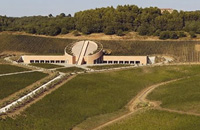 Cantina Petra by Mario Botta in Suvereto
| ||
| Azienda Agricola Petricci e del Pianta | Loc. San Lorenzo 20 | 57028 - Suvereto - (LI) www.petriccidelpianta.it |
|||
| Azienda Agricola Poggio Rosso | Loc.Poggio Rosso,1 | 57025 - Populonia - (LI) |
|||
| Azienda Agricola Rigoli | Via degli Ulivi 8, Loc. Cafaggio | 57021 - Campiglia M.ma - (LI) |
|||
| Azienda Agricola RUBBIA AL COLLE | Loc. Poggetto - Suvereto www.fratellimuratori.com |
|||
| Azienda Agricola Russo | via Forni, 71 | 57028 - Suvereto - (LI) |
|||
| Azienda Agricola San Giusto di Bonti Pierluigi | Loc. Salivoli, 16 | 57025 - Piombino - (LI)Loc. Salivoli, 16 | 57025 - Piombino - (LI) |
|||
| Podere San Luigi | Via dell'Arsenale, 16 | 57025 - Piombino - (LI) www.poderesanluigi.li.it |
|||
| Azienda Agricola Sant'Agnese F.lli Gigli | Loc. Campo alle Fave 1 | 57025 - Piombino - (LI) |
|||
| Tenuta Casa Dei | Loc. S. Rocco | 57028 - Suvereto - (LI) |
|||
| Azienda Agricola Tua Rita | Loc. Notri, 81 - Suvereto www.tuarita.it |
|||
| Podere Tuttisanti | Loc. Asca di Fiorentina | 57020 - Piombino - (LI) |
|||
| Azienda Agricola Valdamone | Loc. Valiamone, 119 - San Lorenzo www.valdamone.com |
|||
Consorzio La Strada del Vino Costa degli Etruschi George Ferzoco, Book Il Murale di Massa Marittima - The Massa Marittima Mural, Centre for Tuscan Studies at the University of Leicester, and published by the Consiglio Regionale della Toscana, Firenze (English, Italiano).
|
|||
[1] Foto Assianir, licenziato in base ai termini della licenza Creative Commons Attribuzione-Condividi allo stesso modo 4.0 Internazionale [2] Source: Costa degli Etruschi - Official web site | www.costadeglietruschi.it |
|||
App Download Available on the App Store |
|||

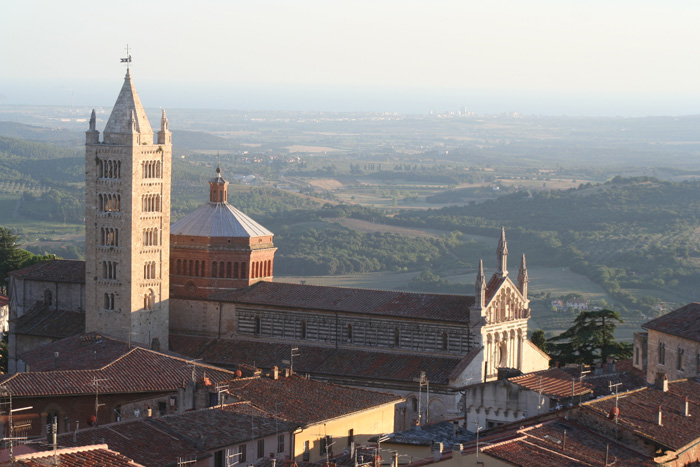
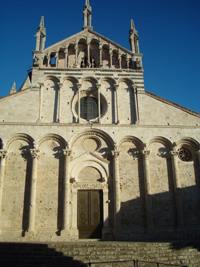 Duomo, dedicated to San Cerbone
Duomo, dedicated to San Cerbone